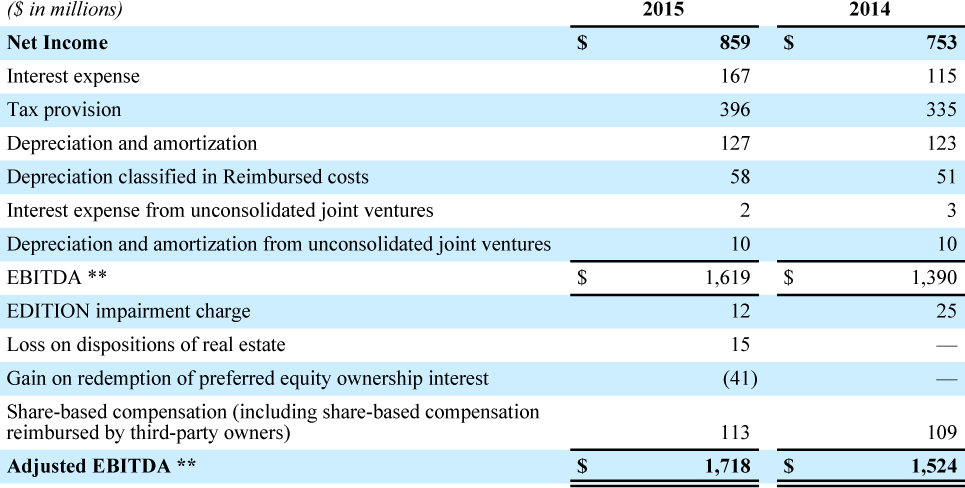Financial Information
Jump to a Section:
PART II
Item 7. Management’s Discussion and Analysis of Financial Condition and Results of Operations.
Adjusted Earnings Before Interest Expense, Taxes, Depreciation and Amortization (“Adjusted EBITDA”)
Earnings Before Interest Expense, Taxes, Depreciation and Amortization (“EBITDA”), a financial measure not required by, or presented in accordance with, U.S. generally accepted accounting principles (“GAAP”), reflects net income excluding the impact of interest expense, provision for income taxes, and depreciation and amortization. Our non-GAAP measure of Adjusted EBITDA further adjusts EBITDA to exclude (1) the pre-tax EDITION impairment charges of $12 million in 2015 and $25 million in 2014, which we recorded in the “Depreciation, amortization, and other” caption of our Income Statements following an evaluation of our EDITION hotels and residences for recovery; (2) the $15 million pre-tax loss on dispositions of real estate, which we recorded in the “Gains and other income, net” caption of our Income Statements in 2015; (3) the $41 million pre-tax gain triggered by a mandatory redemption feature of a preferred equity investment in 2015; and (4) share-based compensation expense for all periods presented.
We believe that Adjusted EBITDA is a meaningful indicator of our operating performance because it permits period-over- period comparisons of our ongoing core operations before the excluded items and facilitates our comparison of results before these items with results from other lodging companies, and because it excludes certain items that can vary widely across different industries or among companies within the lodging industry. For example, interest expense can be dependent on a company's capital structure, debt levels, and credit ratings, and accordingly interest expense's impact on earnings varies significantly among companies. Similarly, tax positions will vary among companies as a result of their differing abilities to take advantage of tax benefits and the tax policies of the jurisdictions in which they operate. As a result, effective tax rates and provision for income taxes can vary considerably among companies. Our Adjusted EBITDA also excludes depreciation and amortization expense which we report under “Depreciation, amortization, and other,” as well as depreciation included under “Reimbursed costs” in our Income Statements, because companies utilize productive assets of different ages and use different methods of both acquiring and depreciating productive assets. These differences can result in considerable variability in the relative costs of productive assets and the depreciation and amortization expense among companies. We also exclude share- based compensation expense to address the considerable variability among companies in recording compensation expense because companies use share-based payment awards differently, both in the type and quantity of awards granted.
Adjusted EBITDA has limitations and should not be considered in isolation or a substitute for performance measures calculated under GAAP. This non-GAAP measure excludes certain cash expenses that we are obligated to make. In addition, other companies in our industry may calculate Adjusted EBITDA differently than we do or may not calculate it at all, which limits the usefulness of Adjusted EBITDA as a comparative measure.
We present our 2015 and 2014 Adjusted EBITDA calculations that reflect the changes we describe above and reconcile this measure with Net Income in the following table:


